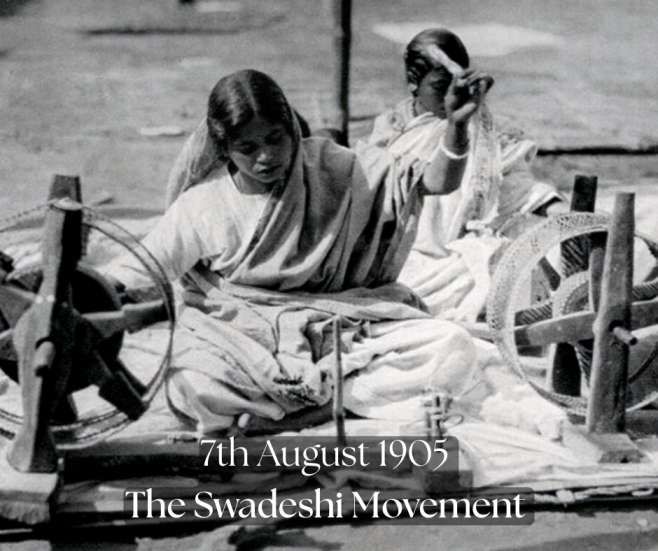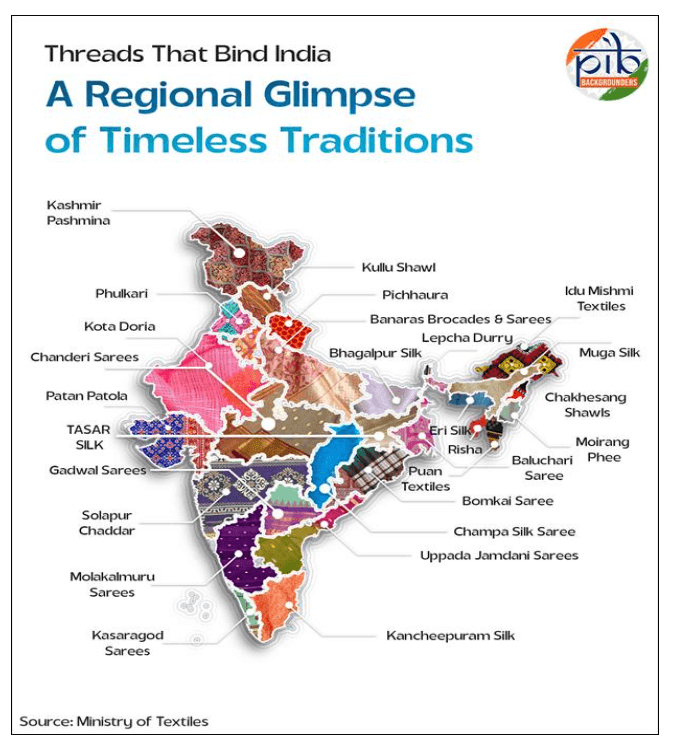National Handloom Day 2025: Celebrating India’s Handloom Heritage
Aug, 2025
•6 min read
Why in News?
The 11th National Handloom Day will be celebrated on 7th August 2025 at Bharat Mandapam, New Delhi. This celebration marks India’s handloom legacy and its link to the 1905 Swadeshi Movement.
Why Cover This Topic for UPSC?
- Important for Prelims (Art & Culture, Current Affairs)
- Relevant to Mains GS Paper I (Indian Heritage and Culture)
- Linked to the Swadeshi Movement in Modern Indian History
- Showcases government schemes and initiatives in the textile sector
- Useful for Essay and Ethics (themes like self-reliance, sustainability)
About National Handloom Day 2025
The 11th National Handloom Day will be celebrated on 7th August 2025 at Bharat Mandapam, New Delhi, under the Ministry of Textiles. The theme for 2025 is "Handlooms: Empowering Women, Empowering the Nation", highlighting empowerment and self-reliance in the handloom sector.
The celebration will be graced by the Hon’ble President of India, who will present the Sant Kabir Handloom Awards and National Handloom Awards for 2024.
History of National Handloom Day: From Swadeshi to Self-Reliance

The handloom sector played a crucial role in India’s freedom struggle. On 7th August 1905, the Swadeshi Movement was launched as a response to the British partition of Bengal. It called for the boycott of foreign goods and promoted the use of indigenous products, especially handwoven textiles, as a symbol of national pride and economic resistance.
To honour this spirit, the Government of India declared 7th August as National Handloom Day in 2015. The first celebration was inaugurated by Prime Minister Shri Narendra Modi in Chennai. Since then, this day is observed every year to:
- Celebrate the weaving community
- Recognise their contribution to the nation’s cultural and economic fabric
- Promote self-reliance by supporting traditional and sustainable crafts
- To raise awareness about the handloom industry and its role in employment
- To encourage younger generations to appreciate and engage with traditional weaving practices.
- To showcase government initiatives and schemes supporting the handloom sector.
Now, let’s take a closer look at the roots of India’s handloom industry in shaping our cultural and economic fabric.
India’s Handloom Legacy: A Living Tradition of Art and Skill
The Indian handloom industry is one of the oldest and most vibrant cottage industries globally. Remarkably, India contributes 95% of the world’s handwoven fabric, making it the global leader in handloom weaving.
Indian weavers are renowned for their expertise in hand-spinning, weaving, and printing intricate patterns. These techniques have been passed down for generations in villages and small towns across India.
Handlooms in Rural India: Livelihood, Legacy, and Empowerment
Beyond tradition and art, handloom weaving is a major source of livelihood across India. Here’s why the handloom sector is so vital at the grassroots level:
- Home-based and low-cost: Weaving is mostly done at home using simple, manual looms.
- Largest cottage industry in India: Over 35.22 lakh households are engaged in weaving and allied activities (4th Handloom Census, 2019–20).
- Women at the forefront: Nearly 72% of handloom weavers are women, making it a strong force for economic empowerment and independence.
- Sustainable by nature: Handlooms are eco-friendly, relying on manual work rather than electricity or machines.
- Carriers of heritage: Every weave, from Banarasi to Kanjeevaram, tells a unique story of India’s rich cultural legacy.
Also cover this latest current topic: Kargil Vijay Diwas 2025: Honouring 26 Years of Valour and Victory
India’s Handloom Diversity: A State-Wise Overview
India’s handloom sector reflects the country’s cultural, geographical, and artistic diversity. As part of Art & Culture (GS I) and Economy (GS III), regional weaves link traditional knowledge with livelihoods, sustainability, and heritage.

India produces a variety of fibers, including Khadi, cotton, jute, linen, and rare fibers like Himalayan nettle, each woven into fabric using age-old methods. Every state in India has developed its distinctive handloom traditions.
- Rajasthan: Known for its tie and dye techniques like Bandhani and Leheriya.
- Madhya Pradesh: Famous for Chanderi and Maheshwari weaves.
- Uttar Pradesh: Known for its intricate Jacquard and Brocade weaves, especially in Varanasi (Banarasi silk).
- Odisha: Home to Bomkai and Kotpad weaves.
- Maharashtra: Famous for the Paithani saree, made from fine silk.
- Kerala: The Balarampuram handloom is known for its unbleached cotton and golden borders.
- West Bengal: A hub for weaves like Jamdani and Baluchari.
- Assam and Northeast India: Known for Eri, Muga, and Tussar silk, these regions produce eco-friendly, cruelty-free silk fabrics with natural shine and strength.
- Jammu & Kashmir: World-renowned for woollen handlooms like Pashmina, Shahtoosh (now banned due to wildlife protection), and Cashmere—luxurious, soft, and warm textiles.
Indian Handlooms in Global Markets
Indian handlooms are widely appreciated across the world for their rich textures, natural colours, and intricate craftsmanship.
Export Highlights (FY 2024–25)
India’s handloom exports reached over 20 countries, with the USA leading as the top importer. Here are the top 5 importers:
- USA
- UAE
- Netherlands
- France
- UK
What’s Being Exported?
According to export data for FY 2024–25:
- Made-ups (curtains, cushion covers, table linen): 42.4%
- Floor coverings (rugs, carpets, mats): 40.6%
- Clothing accessories: 12.7%
- Fabrics: 4.3%
Let’s look at focused government schemes & initiatives that support and strengthen the handloom sector.
Key Government Schemes for Handloom Sector Development
Between 2020-21 and 2024-25, the budget allocation for handloom schemes has increased from ₹219.85 crore to ₹367.67 crore. To achieve this, the Ministry of Textiles implements several targeted schemes.
- National Handloom Development Programme (NHDP): Holistic support to weavers through financial aid, design innovation, marketing access, and infrastructure like Urban Haats.
- Raw Material Supply Scheme (RMSS): Ensures the supply of quality yarn at subsidised rates, including dyed yarns, to help weavers stay competitive.
- MUDRA Loan Scheme: Offers low-interest loans (6%) with margin money support and credit guarantees to individual weavers and weaver organisations.
- Certification Schemes (Handloom Mark & India Handloom Brand): Build trust and branding for high-quality handloom products, adopted by leading fashion brands.
- Small Cluster Development Programme (SCDP): Offers up to ₹2 crore per cluster for upgrading looms, lighting, infrastructure, and product design.
- Hathkargha Samvardhan Sahayata: 90% assistance for modern looms and accessories to improve fabric quality and output.
- GI Protection: Helps register traditional weaves under the GI Act to protect regional identities (104 handloom products registered).
- Digital Platforms (GeM & IndiaHandmade): Over 1.80 lakh weavers onboarded to GeM and 11,410 products listed on IndiaHandmade.com for direct digital sales.
Other Welfare Measures include life and accident insurance (PMJJBY, PMSBY), financial support for senior awardee weavers (₹8,000/month), and scholarships (up to ₹2 lakh/year) for their children pursuing textile education.
Also read: Prime Minister Dhan-Dhaanya Krishi Yojana
Way Forward
As our Hon’ble Prime Minister rightly said, “We take immense pride in the rich heritage and vibrant tradition of handlooms across our nation. We also cherish the efforts of our artisans and reiterate our commitment to be ‘Vocal for Local.”
Through new ideas, collaborations, and technology, the handloom sector is steadily moving toward resilience and renewal. We reaffirm our collective promise to:
- Empower artisans, especially women
- Preserve India’s rich weaving traditions
- Promote sustainability and self-reliance
- Strengthen a future where tradition meets innovation
Must read: PM Modi at Gangaikonda Cholapuram: Understanding the Chola Legacy of Bharat
Unlock your UPSC success with SuperKalam! Get instant doubt clearance, customized study plans, unlimited MCQ practice, and fast Mains answer feedback.
Explore SuperKalam's Resources and set yourself on the path to success!

![Aravali Range in News [UPSC 2025]](/_next/image?url=https%3A%2F%2Fblog-media.superkalam.com%2Faravali_hills_f4a51f37bf.jpeg&w=3840&q=75)
![MGNREGA Vs VB-G RAM G [UPSC 2025]](/_next/image?url=https%3A%2F%2Fblog-media.superkalam.com%2FMGNREGA_vs_GRAMG_ea46241736.jpeg&w=3840&q=75)